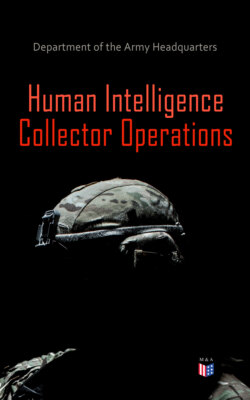Читать книгу Human Intelligence Collector Operations - Department of the Army Headquarters - Страница 96
OPERATIONAL CONSIDERATIONS RESERVE COMPONENT INTEGRATION
Оглавление4-50. Given the Army’s OPTEMPO and force structure, the integration of RC forces into the AC is highly likely for future operational deployments. Commanders must identify their requirements early and establish proactive coordination (both in garrison and while deployed) with their RC counterparts to fully integrate them during all phases of training and operations. During operations that include significant RC participation, an RC liaison officer normally will be assigned, either temporarily or permanently (at higher echelons), at the appropriate level of command. The commander and staff must ensure that the RC LNO is involved in all aspects of operational planning and execution.
4-51. There are three general categories of RC augmentation:
Category 1: Formation of specialized units that include a fully integrated AC and RC TOE. The activation of the RC of these units is required for their full operational capability.
Category 2: Augmentation of active duty units by RC units to fill out unit strength levels or to provide additional functionality. For example, an AC division might require additional HUMINT teams to support it during a stability operation. If a division required one additional team, it should request a team and not request four HUMINT collectors. If the requirement is for three additional teams, it should request a HUMINT platoon with its organic C2 and OMTs.
Category 3: The requirement for individual augmentees. This usually occurs when a unit has the C2 structure but needs either additional personnel or additional capability within the command structure. For example, a unit may have a HUMINT platoon but the platoon is at 50 percent strength. Individual augmentation is the easiest method of integration since the individual is integrated in the same manner as any replacement. The augmented unit normally is required to provide all equipment other than initial issue-type equipment.
4-52. There are several items to consider in unit augmentation:
Accurate Identification of Requirements: During the MDMP, units need to identify those mission-essential capabilities not already present in the unit. The G3/S3, working in conjunction with the G1/S1, considers options that may include RC augmentation of organic units although the final decision to employ RC units is usually determined at Headquarters, Department of Army (HQDA). The requirement for augmentation is forwarded through appropriate personnel channels to US Army Forces Command (FORSCOM) and HQDA, which will identify the appropriate units or personnel. If approved, they will work with the appropriate agencies to establish the timeline in which the units can respond on the Time-Phased Forces Deployment Data List (TPFDDL). When developing requirements, the requesting unit must be sure to articulate its needs accurately, specifying required skills, numbers, and any additional skill identifiers (ASI). [Example: Request augmentation by a HUMINT platoon consisting of at least a platoon headquarters, three HCTs, one OMT, two linguists, and one CI/HUMINT Automated Tool Set (CHATS) proficient operator. The augmenting element will be operating in support of the commander’s force protection program in the gaining unit’s AOR.]
Activation Timeline: Units need time to mobilize and conduct any additional collective and individual training that may be specific to the unit’s mission or operational environment. The requesting unit needs to be aware of the time required to activate the requested RC and that there may be differences in levels of training or equipment. Timelines should be established by FORSCOM to allow resolution of these problems and should be reflected in the commander’s operational planning sequence. Timelines will vary from unit to unit and mission to mission.
Training: USAR and ARNG units usually cannot train their units or individuals to the same proficiency as the AC. Normally, this is due to the limited amount of training time. Because of this limitation, a certain degree of train-up prior to deployment may be necessary. Commanders should identify available training opportunities and request the participation of personnel identified for augmentation. For an ongoing mission, you should also plan for an extended “right seat ride” mission handover period once the individuals or unit arrives in the theater of operations.
Command and Control: If the RC augmentation requires activation of an entire unit, it should include their C2 element. If the augmentation is by individuals, then they will fall under the command and control of the gaining units.
Time on Active Status: USAR and ARNG soldiers are restricted as to the amount of time they can remain on active status. This timeline begins on the date of mobilization and ends on the day the soldier leaves active duty status. Deployed units must take this into account when conducting continuous operations and must identify the requirement to replace RC forces early enough to allow for the required training and handoff procedures.
Experience: While RC personnel normally lack current military experience, they often perform jobs in the civilian sector that either mitigate this lack of experience or they are able to bring a new and useful capability with them. Care should be taken that reservists who have civilian jobs which are similar to their HUMINT MOS (such as police officers or investigators) recognize the different constraints under which they operate in the military environment. For example, police officers who might normally task informants with minimal oversight cannot do that in their position as a HUMINT collector. Commanders should try to capitalize on these skills, but ensure proper training and understanding of the policies and regulations that govern HUMINT collection operations.
